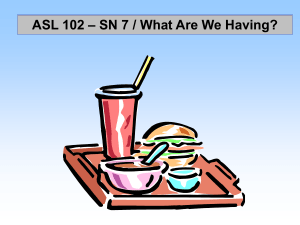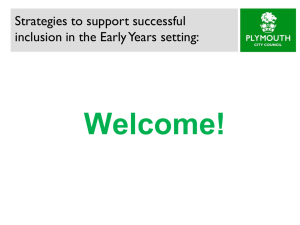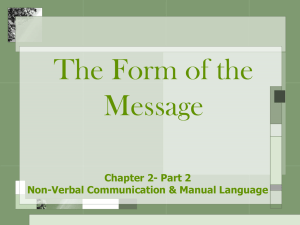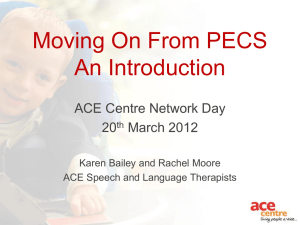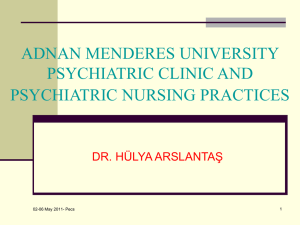Non-Verbal Communication Presentation
advertisement
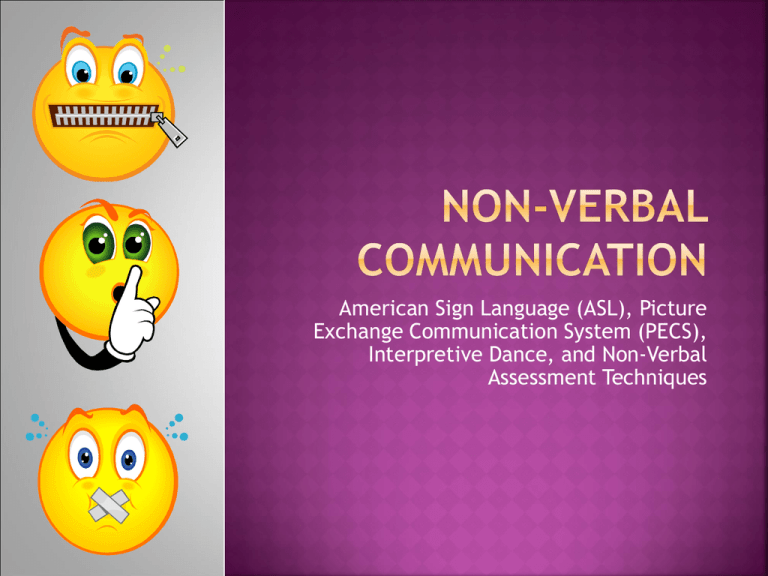
American Sign Language (ASL), Picture Exchange Communication System (PECS), Interpretive Dance, and Non-Verbal Assessment Techniques Many believe that ASL was formed in the beginning of the nineteenth century, but no on is certain of when it first came about. All forms of sign language are different, depending on the origin language. Most children who are born deaf will either acquire it from their parents if they are also ASL users, or will learn it alongside their parents if they have hearing parents who must practice it as well. As with any language acquisition, ASL is better learned as early as possible for children to utilize it properly. Resource: http://www.nidcd.nih.gov/health/hearing/asl.asp There are numerous different disorders that can leave students with the inability to communicate verbally with others: Aphasia (A speech disorder that’s the effect of another medical condition, i.e. a stroke, head injury, etc.) Autism (Several forms of Autism leave children and adults with the inability to speak coherently, but not all of them do.) Cerebral Palsy (As with Autism, there are varying degrees of this disease; people with CP who have retained some amount of motor function may be able to utilize ASL, while others may not be able to.) Down Syndrome (Because of the symptoms of Down Syndrome, ASL gives some people with it the ability to communicate, though if they are able to convey themselves verbally it is oftentimes more encouraged.) Resource: http://deafness.about.com/cs/signfeats1/a/nonverbal.htm http://www.youtube.com/watch?v=Zqb7xjNP BXg&feature=channel http://www.youtube.com/watch?v=m5Tu9KJPzs&feature=channel These kinds of basics can be taught to students in order for them to communicate with classmates that are deaf or use ASL as their primary language. In classrooms that have students who communicate using ASL, it can be helpful to have resources such as charts or books that will allow their classmates to look up the means to talk to them, especially if there is going to be group work. In many cases, students who are non-verbal will be assigned an interpreter for the classroom so that they can follow along with lectures and spoken instructions. There may be cases, however, where there is not one in the classroom to aid them. In these instances, it will be necessary for the teacher to either write everything up on the board or, since it would be simpler, to create a sheet for the student explaining everything that they will be going over in class. (Creating these will also help if the student has difficulty writing or taking down information as well, and give them something concrete to work off of.) ASL takes a while to learn, especially since most adults lose the ability to retain new languages, but learning simple phrases to explain certain activities and situations (i.e. for a fire drill, field trip, etc.) can help you establish a system of communication with your student so that they will not have to rely entirely on their interpreter, and will allow you to communicate with them if something unforeseen happens. There are countless books and videos available about ASL that give instruction, and courses are offered at different institutions on learning it more extensively (universities, YMCA, etc.) http://www.aslpro.com/ - ASL Pro is a free site for educators to use. It has dictionaries, videos, and other resources for teachers. http://www.masterstechhome.com/ASLDICT.html This is a basic dictionary of ASL words, which are described for the reader to try out on their own. http://www.flagetiquette.us/images/americ an-sign-language-pledge-of-allegiance.png How to sign the Pledge of Allegiance. There are also countless printed resources on ASL. PECS was originally designed for children and adults with autism as a means for them to organize and understand everyday tasks, and be able to communicate with their family, friends, classmates/teachers, and so forth. PECS can also be used, however, to help students with other disorders that either make it hard for them to communicate verbally, or have trouble comprehending verbally given instructions. (For example, some people who have autism can speak, but have trouble understanding the things that are said to them, so visual aids can be incredibly helpful for them.) PECS usually involve a combination of images and sometimes brief written messages that users can organize for a variety for uses: PECS can be used as schedules for daily tasks, for laying out parts of assignments, and so forth. There’s really no limit on the potential that they have, and can be made to suit just about any purpose. http://www.youtube.com/watch?v=mUQg0W NLQuA This video shows PECS being used in classrooms. An explanatory site: http://autism.healingthresholds.com/therapy/picture-exchangecommunication-system-pecs (Gives a detailed explanation of the benefits of PECS, the potential disadvantages, and talks about the six stages of how PECS should be introduced to a child.) http://www.pecsusa.com/ A for-profit site that has PECS sets that can be ordered, as well as seminars for learning how to utilize them to their full potential. http://trainland.tripod.com/pecs.htm A wonderful site that has many colored images with labels for PECS systems. http://www.autistas.org/pecs.htm This site is not in English, but the PECS pictures are, and there’s a nice variety of them. http://www.dotolearn.com/ Has a great mix of free and paid for resources, and additional materials available for teachers as well. Interpretive dance is a means for students to show their ideas and artistic expression non-verbally. Interpretive dance is sometimes used already in extracurricular activities, such as variety and talent shows, by students. Incorporating it into the classroom would give them a creative means of expression that may already interest them. A good resource for lesson plans involving interpretive dance is Lesson Planet: http://www.lessonplanet.com/search?grade=all&key words=interpretive+dance&media=lesson&rating=3&s earch_type=related This site requires a free trial membership, but gives access to many different kinds of ways to incorporate this into a variety of lessons. Typical types of non-verbal assessment would be paper tests, quizzes, assignments, and so forth that are given daily in schools. Assessments done on paper are typically nonverbal; most students do not require any verbal instruction, since they are able to read the directions. But most teachers utilize non-verbal assessment in these ways numerous times during the school year. Research has conducted to prove the validity of non-verbal intellectual tests and what they can show to researchers and educators alike. “From the beginning, test developers have faced the challenge of assessing the cognitive functioning of individuals who lack the ability to demonstrate their cognitive skills using the language of the culture in which they live.” (McCallum, 2001, p. 2) Strictly non-verbal assessment is necessary for testing the knowledge and cognition of students and people who may not be able to verbally show their intellect. For example: non-verbal assessment is essential for testing the intelligence of a student who is deaf and cannot be tested properly using verbal instructions. There are also several other reasons to use nonverbal assessment: “Each of these measures may be used in varying degrees to access general cognitive and intellectual ability, to screen students potentially eligible for special services, to more fairly access students with limited English proficiency or with diverse cultural and educational backgrounds, to screen students who would be disadvantaged by traditional languageloaded assessments (e.g. deaf students), and to access what students can do despite whatever language, motor, or color-vision limitations they may have.” (McCallum, 2001, p.15) Non-verbal assessment is a means through which students who cannot verbally show their knowledge can show their intelligence. Students who may be deaf, have cerebral palsy, who other disorders that impair their verbal abilities can have a means to show that they either do or do not know what has been taught to them. There are many people who have certain disabilities that still function at the same level as people without any disabilities, but without this kind of assessment, there is no way for them to show this. Examples of specific non-verbal tests that can be used for this purpose: Unidimensional (Beta III, CTONI, GAMA, NNAT, RPM, TONI-III) These test specific abilities and content. Then there is the UNIT test (Universal Non-Verbal Intelligence Test) which tests a more broad scope of someone’s capabilities, including their strengths and weaknesses , but also can be used by researchers to gain a global sense of what education is doing right and wrong in their assessment techniques. Youtube videos: http://www.youtube.com/watch?v=Zqb7xjNPBXg&feature=chann el http://www.youtube.com/watch?v=m5-Tu9KJPzs&feature=channel http://www.youtube.com/watch?v=xGhBxghJF9A&feature=related Online Resource: http://www.nidcd.nih.gov/health/hearing/asl.asp McCallum, S., Bracken, B., and Wasserman, J. (2001). Essentials of Non-Verbal Assessment. New York: John Wiley & Sons, Inc.
